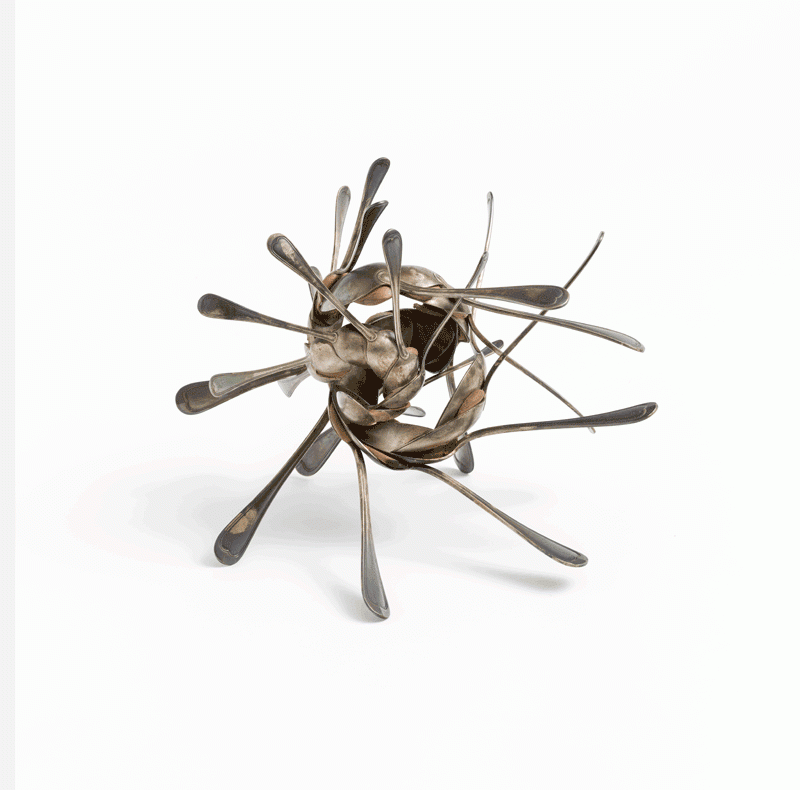Galerie Chantal Crousel, Paris, 26 November – 11 February 2017
Running in parallel to a supposed retrospective at Centre Pompidou that Jean-Luc Moulène twisted into what he calls a ‘retro-prospective of protocols’ featuring mainly new sculptures from 2015–6, Ce fut une belle journée presents another ensemble of recent works: 16 previously unshown hybrid objects, supported by knowingly naive drawings and two videos. Whereas the sixty-one-year-old Frenchman gained recognition during the late 1990s for his work in photography, his practice has since become essentially sculptural, leaving art critics chewing their nails over the impossible task of defining his overtly anarchistic, shapeshifting aesthetics. The way the artist verbalises his ideal sculptures should give you a hint as to why. Here is an attempt to paraphrase bits and pieces of concep tual gibberish from his latest interviews: ‘my utopia for artworks is to produce mind tools to describe complexity, using mathematical knot and set theories to affirm disjuncts based on Michel Journiac’s notion of body as conscious social meat.’ Got that? Me neither.
Armed with the knowledge that mathematical knots are embedded circles with no ends to tie – not unlike Moulène’s heteroclite exhibitions – and for the sake of proceeding through this review without resorting to Journiac’s performed cannibalism in his 1969 Messe pour un corps (he offered his public a sausage made with his own blood), I’ll turn to Seule au sommet, Paris, 2016 (2016), displayed in the back of the gallery. According to the artist, this statuette, made from seashells and epoxy resin, was inspired by Bubu, mascot of the French literary review Le Grand Jeu (1928–32). This fictional character is the o spring of Baubo, a mythological female figure often represented with her face in the body and her vulva in the chin, and Ubu Roi, the leading protagonist of the 1896 eponymous play by Alfred Jarry, who was not only the French precursor of Surrealism, but also the inventor of ’Pataphysics, the wonderfully absurd science of imaginary solutions. (As chance would have it, for months I’ve contemplated joining the Collège de ’Pataphysique in exchange of a modest €40 fee, taking my commitment to useless research and nonsensical digression very seriously.)
Now call me crazy, but I swear I heard Bubu whispering to me: “Don’t let Moulène fool you with maths, instead hijack his show with the first random idea that sparks a fire in your guts.” Surveying the images and captions of his curious artefacts – among others, the stunning, reptile- like Créature, Paris, 2016 (2016) covered with false nails, the wood knot Tête couronnée, Paris, 2013 (2013) crowned with five of the artist’s teeth, the portmanteau work ConquOs, Paris – Mexico (2016) joining together a bone and a conch shell, as well as Silex neufs, Barneville, 2013 (2013) and Poing, Barneville – Paris, 2016 (2016), both brain-shaped assemblages of flint chunks – the overall ensemble begins to read as some kind of anthropological display, and by association, the name of an eminent French paleoanthropologist slowly emerges in my mind: André Leroi-Gourhan. Leafing through the latter’s 1965 masterwork Le Geste et la parole, one might stumble upon this passage, which roughly translates into: ‘Australanthropians seem to have possessed their tools the same way as an animal has claws […] as if their brains and bodies had gradually exuded them.’ ’Pataeureka!
It is now with a renewed faith in the nonsensical, then, that I’d like to advance the following hypothesis: whereas twenty-first- century technologies seem to alienate more and more of us, Moulène’s tools exude bodies back, as if the latter were surrealistically pulled over the former. For example, in the show, which remains mostly organic, this subversion additionally assumes the form of Inverse – Reverse, Barneville – Paris, 2016 (2016), an intricate assemblage of branches covered with blue and red paint, which suggests a vascular system, and Silver Puke, Paris, 2013 (2013), a rounded arabesque of spoons, whose shape is equally reminiscent of a rotavirus (the agent that causes vomiting and diarrhoea). Whether or not you’ll choose to validate my ’pataphysical proposition, Moulène’s art is to neurons what an oyster is to gustatory cells: an exquisite acquired taste.
From the March 2017 issue of ArtReview
